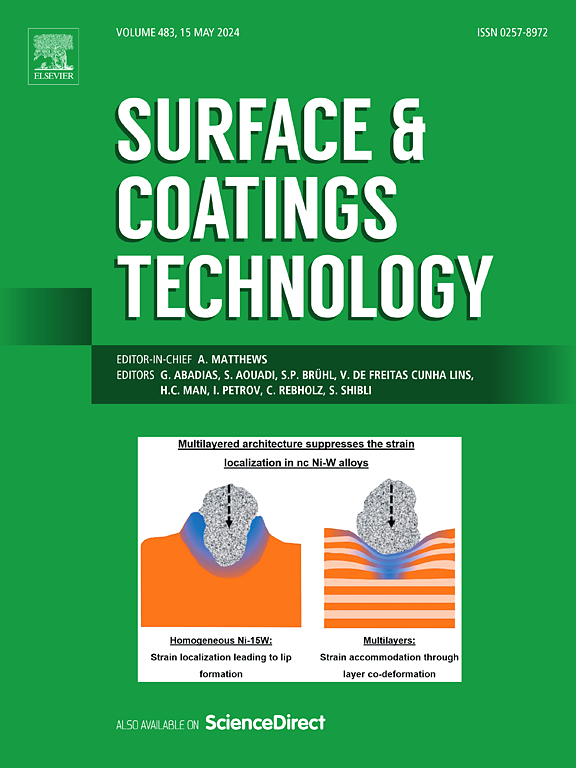High-temperature wear behavior of Tribaloy T400 and T800 coatings prepared by a novel ethanol-fueled HVOF process
IF 5.3
2区 材料科学
Q1 MATERIALS SCIENCE, COATINGS & FILMS
引用次数: 0
Abstract
In this work, Tribaloy T400 and T800 coatings were prepared on 304 stainless steel substrates using a novel ethanol-fueled HVOF process, which is a recently developed liquid fuel HVOF technology. Two sets of spraying parameters, namely E1 and E2, with different oxygen/ethanol ratio were selected in order to obtain dense and high-quality coatings for high-temperature tribological testing. Moreover, the high-temperature wear behavior of the as-sprayed coatings prepared by this new process was studied. The results showed that the T400-E1 and T800-E2 coatings had the highest microhardness and the lowest porosity. Both coatings displayed wear rates of 5.92 × 10−4 and 2.74 × 10−4 mm3 N−1 m−1 in the sliding wear tests performed at room temperature, respectively. The T800 coatings exhibited better wear resistance due to their high contents of Laves phase and Cr. High temperature sliding wear tests were carried out at 400 °C and 800 °C, respectively. It can be inferred that the wear mechanism of the T400 coating at 400 °C mainly consists in oxidative and abrasive wear, whereas that of the T800 coating at 800 °C can be described mainly as oxidative wear with peeling.
采用新型乙醇燃料HVOF工艺制备Tribaloy T400和T800涂层的高温磨损性能
本文采用一种新型的乙醇燃料HVOF技术,在304不锈钢基体上制备了Tribaloy T400和T800涂层。选择不同氧/乙醇比的E1和E2两组喷涂参数,获得致密、高质量的涂层,用于高温摩擦学测试。此外,还对该工艺制备的喷涂涂层的高温磨损性能进行了研究。结果表明:T400-E1和T800-E2涂层的显微硬度最高,孔隙率最低;在室温下进行的滑动磨损试验中,两种涂层的磨损率分别为5.92 × 10−4和2.74 × 10−4 mm3 N−1 m−1。T800涂层具有较高的Laves相和Cr含量,具有较好的耐磨性。分别在400℃和800℃进行了高温滑动磨损试验。可以推断,T400涂层在400℃时的磨损机制主要为氧化磨粒磨损,而T800涂层在800℃时的磨损机制主要为氧化剥落磨损。
本文章由计算机程序翻译,如有差异,请以英文原文为准。
求助全文
约1分钟内获得全文
求助全文
来源期刊

Surface & Coatings Technology
工程技术-材料科学:膜
CiteScore
10.00
自引率
11.10%
发文量
921
审稿时长
19 days
期刊介绍:
Surface and Coatings Technology is an international archival journal publishing scientific papers on significant developments in surface and interface engineering to modify and improve the surface properties of materials for protection in demanding contact conditions or aggressive environments, or for enhanced functional performance. Contributions range from original scientific articles concerned with fundamental and applied aspects of research or direct applications of metallic, inorganic, organic and composite coatings, to invited reviews of current technology in specific areas. Papers submitted to this journal are expected to be in line with the following aspects in processes, and properties/performance:
A. Processes: Physical and chemical vapour deposition techniques, thermal and plasma spraying, surface modification by directed energy techniques such as ion, electron and laser beams, thermo-chemical treatment, wet chemical and electrochemical processes such as plating, sol-gel coating, anodization, plasma electrolytic oxidation, etc., but excluding painting.
B. Properties/performance: friction performance, wear resistance (e.g., abrasion, erosion, fretting, etc), corrosion and oxidation resistance, thermal protection, diffusion resistance, hydrophilicity/hydrophobicity, and properties relevant to smart materials behaviour and enhanced multifunctional performance for environmental, energy and medical applications, but excluding device aspects.
 求助内容:
求助内容: 应助结果提醒方式:
应助结果提醒方式:


